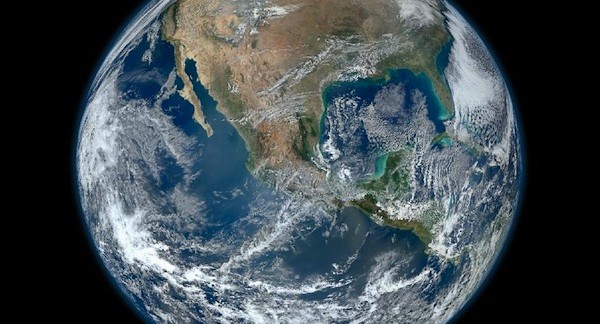It’s Earth Day yet again. Last year, to celebrate the 42nd Earth Day, we took a look at 10 of the most surprising, disheartening, and exciting things we’d learned about our home planet in the previous year—a list that included discoveries about the role pesticides play in bee colony collapses, the various environmental stresses faced by the world’s oceans and the millions of unknown species are still out in the environment, waiting to be found.
This year, in time for Earth Day on Monday, we’ve done it again, putting together another list of 10 notable discoveries made by scientists since Earth Day 2012—a list that ranges from specific topics (a species of plant, a group of catfish) to broad (the core of planet Earth), and from the alarming (the consequences of climate change) to the awe-inspiring (Earth’s place in the universe).
 Even the supposedly pristine Antarctic landscape is marred by trash heaps. Image via Germany Federal Environment Agency Report (PDF)
Even the supposedly pristine Antarctic landscape is marred by trash heaps. Image via Germany Federal Environment Agency Report (PDF)
1. Trash is accumulating everywhere, even in Antarctica. As we’ve explored the most remote stretches of the planet, we’ve consistently left behind a trail of one supply in particular: garbage. Even in Antarctica, a February study found (PDF), abandoned field huts and piles of trash are mounting. Meanwhile, in the fall, a new research expedition went to study the Great Pacific Garbage Patch, counting nearly 70,000 pieces of garbage over the course of a month at sea.
2. Climate change could erode the ozone layer. Until recently, atmospheric scientists viewed climate change and the disintegration of the ozone layer as entirely distinct problems. Then, in July, Harvard researcher Jim Anderson (who won a Smithsonian Ingenuity Award for his work) led a team that published the troubling finding that the two might be linked. Some warm summer storms, they discovered, can pull moisture up into the stratosphere, an atmospheric layer 6 miles up. Through a chain of chemical reactions, this moisture can lead to the disintegration of ozone, which is crucial for protecting us from ultraviolet (UV) radiation. Climate change, unfortunately, is projected to cause more of these sorts of storms.
3. This flower lives on exactly two cliffs in Spain. In September, Spanish scientists told us about one of the most astounding survival stories in the plant kingdom: Borderea chouardii, an extremely rare flowering plant that is found on only two adjacent cliffs in the Pyrenees. The species is believed to be a relic of the Tertiary Period, which ended more than 2 million years ago, and relies on several different local ant species to spread pollen between its two local populations.
4. Some catfish have learned to kill pigeons. In December, a group of French scientists revealed a phenomenon they’d carefully been observing over the previous year: a group of catfish in Southwestern France had learned how to leap onto shore, briefly strand themselves, and swim back into the water to consume their prey. With more than 2,000,000 Youtube views so far, this is clearly one of the year’s most widely enjoyed scientific discoveries.
5. Fracking for natural gas can trigger moderate earthquakes. Scientists have known for a while that whenever oil and gas are extracted from the ground at a large scale, seismic activity can be induced. Over the past few years, evidence has mounted that injecting water, sand and chemicals into bedrock to cause gas and oil to flow upward—a practice commonly known as fracking—can cause earthquakes by lubricating pre-existing faults in the ground. Initially, scientists found correlations between fracking sites and the number of small earthquakes in particular areas. Then, in March, other researchers found evidence that a medium-sized 2011 earthquake in Oklahoma(which registered a 5.7 on the moment magnitude scale) was likely caused by injecting wastewater into wells to extract oil.
6. Our planet’s inner core is more complicated than we thought. Despite decades of research, new data on the iron and nickel ball 3,100 miles beneath our feet continue to upset our assumptions about just how the earth’s core operates. A paper published last May showed that iron in the outer parts of the inner core is losing heat much more quickly than previously estimated, suggesting that it might hold more radioactive energy than we’d assumed, or that novel and unknown chemical interactions are occurring. Ideas for directly probing the core are widely regarded as pipe dreams, so our only options remains studying it from afar, largely by monitoring seismic waves.
 The berries of Pollia condensata were found to produce the most intense color in the natural world. Image via PNAS
The berries of Pollia condensata were found to produce the most intense color in the natural world. Image via PNAS
7. The world’s most intense natural color comes from an African fruit. When a team of researchers looked closely at the blue berries of Pollia condensata, a wild plant that grows in East Africa, they found something unexpected: it uses an uncommon structural coloration method to produce the most intense natural color ever measured. Instead of pigments, the fruit’s brilliant blue results from nanoscale-size cellulose strands layered in twisting shapes, which which interact with each other to scatter light in all directions.
8. Climate change will let ships cruise across the North Pole. Climate change is sure to create countless problems for many people around the world, but one specific group is likely to see a significant benefit from it: international shipping companies. A study published last month found that rising temperatures make it probable that during summertime, reinforced ice-breaking ships will be able to sail directly across the North Pole—an area currently covered by up to 65 feet of ice—by the year 2040. This dramatic shift will shorten shipping routes from North America and Europe to Asia.
9. One bacteria species conducts electricity. In October, a group of Danish researchers revealed that the seafloor mud of Aarhus’ harbor was coursing with electricity due to an unlikely source: mutlicellular bacteria that behave like tiny electrical cables. The organisms, the team found, built structures that traveled several centimeters down into the sediment and conduct measurable levels of electricity. The researchers speculate that this seemingly strange behavior is a byproduct of the way of the bacteria harvests energy from the nutrients buried in the soil.
 Kepler 62f, discovered yesterday, is the most promising exoplanet candidate yet in terms of its potential to harbor life. Image via NASA/Ames/JPL-Caltech
Kepler 62f, discovered yesterday, is the most promising exoplanet candidate yet in terms of its potential to harbor life. Image via NASA/Ames/JPL-Caltech
10. Our Earth isn’t alone. Okay, this one might not technically be a discovery about Earth, but over the past year we have learned a tremendous amount about what our Earth isn’t: the only habitable planet in the visible universe. The pace of exoplanet detection has accelerated rapidly, with a total of 866 planets in other solar systems discovered so far. As our methods have become more refined, we’ve been able to detect smaller and smaller planets, and just yesterday, scientists finally discovered a pair of distant planets in the habitable zone of their stars that are relatively close in size to Earth, making it more likely than ever that we might have spied an alien planet that actually supports life.
Courtesy Smithsonianmag.com

